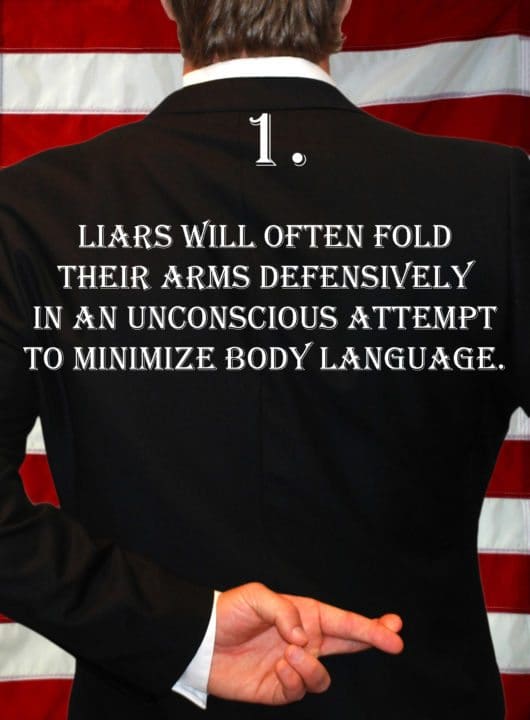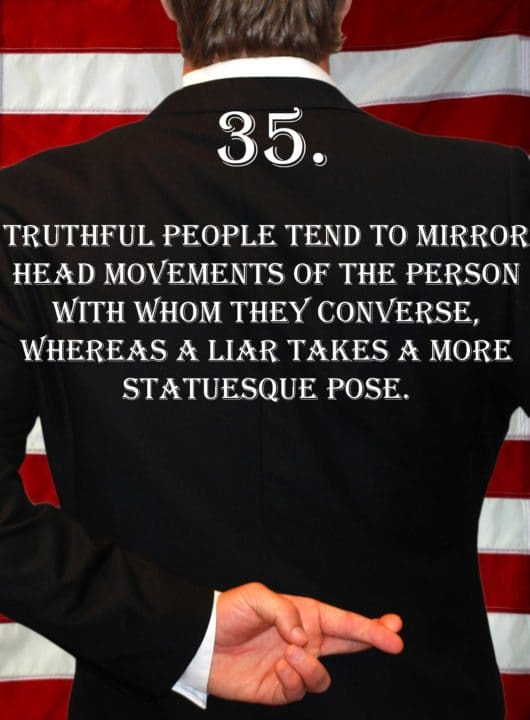
Deception Tip 1:
Liars will often fold their arms defensively in an unconscious attempt to minimize body language.
Listen To The Podcast!
E1 – Folding Arms – Deception Tips Podcast – Click Here To Subscribe
Podcast Transcript
Hello, and welcome to the deception tips podcast. Where you will learn amazing cues to detect deceit that will help you read people like never before. I’m your host Spencer Coffman. Let’s get started.
Welcome to Episode 1 of the deception tips podcast. Today we’re going to examine one of the deception tips, the first one. Deception tips are something that is very essential to help you learn how to read people and detect deceit.
Understanding body language is something that is very important in today’s society. Especially with what is going on now. More people now, than ever before, are stepping up and wanting to learn what is going on with body language. People are fascinated by all of these things that are displayed by us as humans.
Why they are fascinated is because these behaviors are universal. They show up in everyone across all races no matter what language you speak, no matter where you’re from, whether you grew up in the West, in a 3rd world, or in the middle of the jungle.
These behaviors and mannerisms are universal across everybody and that is why people are so fascinated with them. Because, if you can look at someone without knowing what they’re saying, you can just watch them whether you have it on mute or whether you’re in a different room, or whether they’re speaking a different language.
And if you can instantly know whether or not that person is telling the truth. Wouldn’t you want to do that? Wouldn’t you want to know? Of course, you would. And that is why this is taking the world by storm.
Look at all of the politicians out there. What if, when you were watching the news, you could see them talking about their campaign as they’re running and you know their responses to certain questions and you say, “you know what, I’m not going to vote for him or I am going to vote for her” or whatever the case may be because you can know, you can tell whether or not they are lying, whether they are being deceptive or not.
These deception tips are really going to help you do that. This is the first one. You’re going to learn what it is, you’re going to learn how to spot it, and you’re going to learn what it means. In addition to that, you’re going to learn a whole lot more.
But first, before we get into that. keep in mind that you can always check out the other resources I have available. There is a lot of stuff out there from me and from everybody else.
Deception, as I said, is taking the world by storm. People are tired of being scammed, conned, lied to, and having the wool pulled over their eyes. They’re tired of it. They’re sick of it. They don’t want to be cheated on. They don’t want to have broken hearts. I mean, who does? Do you like the pain and suffering that goes with being hurt?
No, you don’t. Nobody does. If you do, there is a term for that and it’s a sickness. You, like anyone else, are interested in this or you wouldn’t be listening to this podcast. There are tons of other resources out there. You can check mine out. I’ve got books, blogs, this podcast, and videos out there that you can use to learn more about body language.
Now here we are deception Tip Number One: liars often fold their arms defensively in an unconscious attempt to minimize body language. What that means is when someone lies, unconsciously, it means that they will do it without thinking about it. It is universal. A natural reaction.
The reason it is unconscious is that the unconscious mind is non-deceptive. It means that tells the truth. The unconscious brain is very truthful, and it is our conscious mind that is deceptive.
Humans are always plotting to deceive. No matter what the case, they’re scheming and conniving but the unconscious works very, very hard to put that truth out there. It is how it reconciles the difference between conscious and unconscious. If you’re consciously lying, your unconscious is going, to tell the truth. So to balance it out, so that you don’t somehow morally become this evil, nasty person. It’s your conscious way of coping with yourself.
It is like your conscience being pushed through your body so that you can sleep at night, basically is what it is you. Then you’re not thinking about it. When you’re consciously telling this lie, your unconscious is telling the truth.
So somehow, unconsciously it balances out and you’re good to go you can sleep and not worry about it. That’s kind of a simple mechanism behind the reason that the unconscious is truthful. There is a lot more scientific stuff that goes into that, but that is kind of a good way to grasp it and understand it.
The tip again: liars will often fold their arms defensively, in an unconscious attempt to minimize body language defensively because they are defending. They’re defending their truth. Anytime that a liar says something, in the back of their mind, they’re thinking, “Oh no. They’re going to find out,” or “Oh no, they know,” or “They don’t believe me.”
So when they cross their arms they’re defending themselves. It is like when you confront someone in an argument and they immediately become defensive. Right? Because they already know that you don’t believe them. So when a liar gets defensive, that’s when they cross their arms, that’s when they fold their arms.
Why do they do it? why do they fold their arms? Why is that such a lying posture for these people? One of the big reasons is that when people tell a lie, they try to take up as little space as possible because they don’t want people to see what is going on in their bodies.
They do this, unconsciously, because if the conscious mind is telling us this lie, the unconscious is showing these behaviors that are trying to tell the truth to combat this discrepancy. So, unconsciously, you’re going to start minimizing yourself, and consciously, so that there are fewer behaviors to be noticed.
It is like a battle that goes on in your mind that you’re not even thinking about because most of what happens is nonverbal. So you are battling between these two. You’re minimizing yourself to take up less space so that those people out there, like yourself, can eventually be able to read people.
If you can read someone and there is a liar there and that liar starts minimizing himself, or herself so that it makes it harder for you to interpret their body language. That is why they may fold their arms defensively to kind of huddle that up so that you can see less of their body. Then you will have a harder time interpreting what is going on.
Another thing, we kind of touched on this, they take up less space and that is so that you can’t see them. Liars all over are taking up less space and, we’ll get into this more later as the Tips go on, but generally, the more confident a person is they tend to spread out.
Look at the CEO of a company or at a board meeting or something like that. That’s the person with their hands behind their heads, leaning back in the chair, their feet are up on the table, they’re sprawled out. Whereas all the other people have a little 2-foot by 2-foot space at the table for all their notes and everything. The CEOs got the entire end of the table. Right there at the head of the table. Confident people take up more space. When you’re lying, you fold in, you huddle.
When a man folds his arms and a woman folds her arms, they’re not the same. Now, you have to keep in mind that not everybody who folds arms is lying. I just made that a lot harder. I threw a curveball in there.
When someone folds their arms doesn’t immediately mean that they are defensive or deceptive. There are many reasons anyone could perform any of these behaviors. They could consciously be folding their arms. If they’re consciously doing it, that means that it’s not an unconscious way of getting the truth out.
So now you can’t interpret it as deceptive behavior. Anybody can consciously do any of these things, so no matter what the deception tip is, or the sign, people can train themselves to do them consciously. Even things like microexpressions, which will touch on later. And you may even know about them or do some research about them. You can’t train yourself to display certain micro-expressions.
Microexpressions, briefly, are split-second reactions on your face- a twitch, an eye movement, a little muscle spasm, something like that, that happens in a fraction of a second that people can pick up on and see and their unconscious truthful behaviors.
People can train themselves to show those micro-expressions. People can train themselves to cross their arms. They can think and learn when to consciously exhibit some of these deceptive behaviors to throw people off when they lie.
So that makes it a lot more difficult for you when you are trying to interpret the truth. The good thing is, most people out there have not studied this they don’t understand it and they don’t know what goes into it.
So most of the people that you are going to encounter when you see these behaviors are not going to be maliciously trying to deceive you by incorporating these unconscious behaviors into their conscious repertoire of behaviors. So that is a good thing. You can put your mind at ease. And as you get better at this you’ll start to see them and notice them on yourself and others. But right now we’re going to take a break so stay tuned.
Would you like to know if you are being lied to? Lies are everywhere and they could be happening to you. “A Guide To Deception” is a great book filled with information on how to spot lies. Get your copy today online at SpencerCoffman.com
When a man folds his arms it’s higher up on their chest. Due to a woman’s anatomy, their arm folds are more along their belly. That is something to consider. If you see a man who folds his arms along his belly, that’s kind of unusual right?
For most men, when we fold our arms, it’s up on our chest. Kind of like a moment of pride. To puff up. So if he’s folded his arms on his belly, that may not mean is folding his arms he maybe, maybe his stomach hurts. So there are other non-deceptive reasons that people can do any of these behaviors.
In addition to the malicious reasons, they would use these behaviors as another form of deception to try to get you to believe they’re leaking the truth or telling the truth when they’re not.
You know if I told the truth and then folded my arms, and backed up and gave you some behaviors that might be corresponding with deception, then you might think, “oh, he might be lying there,” but I just told the truth and I did that to get you to think I was lying.
But you’re not going to encounter a lot of those people. So that’s not something that you need to worry about yet, but as we go through these deception tips always keep that in mind that any one sign is never enough to determine whether or not someone is telling the truth.
You must look for groups of signs, or patterns, also known as clusters of behavior because if someone folds their arms, they could be cold. Women typically fold their arms a lot more than men. A big reason for that is because they’re usually always colder than men.
You know this to be true. There’ll be the man and the woman and they’re watching a movie together on the couch. They’ve got the blanket, the man gets hot. Throws a blanket over. The woman, can’t get enough blankets. That’s just how it is.
Anatomy-wise and differences, men are usually typically a little bit more hot-blooded, and women are a little bit more cold-blooded. Now again, we’re talking about anatomy, not mentality. When people are folding their arms, keep that in mind. That it’s different between men and women. Women like I said fold their arms more, so if they’re folding their arms, that may not be a potential telltale sign of deception, because it could be, they’re cold.
A lot of people also fold their arms when they’re bored. When people get bored in a conversation, that’s like their way of tuning out. They fold their arms, they might roll their eyes, and might lean back the kind of like, “Look I’m done. I don’t want to talk about this anymore.” Again, that’s partially a defensive behavior. They’re shutting down, they’ve closed off communication with their body. They’ve put that barrier there.
Another reason is it could be a form of comfort. When we’re little we’d like hugs. When you get older, you still like hugs. But why? Because it’s a comfort. It is a squeezing. You feel like someone is holding you. You’re safe.
When you’re in certain positions and you see some people folding their arms, it may not be because they’re deceptive, it may not be because they’re cold, it may not be because they’re bored. It may be because they need a little bit of security.
They’re folding their arms in an effort to kind of hug themselves and they’re pushing on it, you know flexing their muscles as they fold their arms, to give themselves that compressing feeling on their torso, to try to comfort them through whatever situation they’re going through or thinking of.
They may not even be going through a situation. They could be having the most fun in their life. But all of a sudden, a thought hits their head and they revert back to something and they fold their arms, clinch in, to try to comfort and get away from that thought. So, there are a number of reasons that people can fold their arms, which is why it is essential, that you look for patterns in clusters of behavior.
What is a cluster? A cluster of behaviors in body language would mean doing multiple deceptive acts at the same time. Not just speaking, but multiple deceptive body language displays or demonstrations. So, since this is tip number one, you may not know of a lot of others.
So we’re going to get into them. I mean you’re going to learn of them later. So if someone folds their arms, that could be one potential sign. If they’re talking to you and their lips are moving. No. I’m just kidding there could be another sign.
But when they’re talking to you, their voice could change. There are a number of vocal things that could happen that could tip you off and say, “Wait a minute, this could be a lie.” Then you see them fold their arms. Then you see them step backward.
Or you see them cross their legs and do multiple deceptive behaviors at once. Now you can know that they are lying. You see that and you say, “Hey, look.” This is one that puts your alert up. Now you start looking for others. Okay. “Am I seeing anything else on them that is showing that this is deception?” and you say “no.” Okay. Maybe they’re folding their arms for some other reason.
But if you see them fold their arms and something else is happening now. You may think okay they fold their arms- check. Okay. They’re backing up- check. Okay. The voice changed-check. They’re lying.
But it’s not going to happen in a sequence like that. Most of the time these behaviors are going to happen instantly, simultaneously, and they may only stay there for a fraction of a second or even a couple of seconds.
A genuine unconscious emotional expression is very, very brief. It happens quickly, it goes away quickly. That’s how you know it’s real. This is why any time you’re in a position where you could be in a deceptive situation or you want to make sure you’re not getting the wool pulled over your eyes, you need to be paying attention all the time. 100%.
Because if you look away and are distracted you may have missed that emotional expression of deception. But don’t worry if you do, because there will be more. Liars always continually display these signs because the unconscious is truthful.
Simply because someone crosses their arms. It doesn’t mean they are being defensive. However, if you see someone cross their arms, step backward, maybe they frown, shake their head? Now you can know they’re being defensive.
You didn’t even need to listen to this podcast to know that when someone frowns, shakes their head, and backs away. You can immediately tell. You just know. You’re like, “that person is not interested. They don’t like what I’m saying. They’re not with it.” So you can immediately know that based upon that cluster or pattern of behaviors. But that is the main thing in deception tip one, liars will often fold their arms defensively in an unconscious attempt to minimize body language.
Keep an eye out for clusters of behaviors because simply because someone is folding his or her arms does not always mean they’re being deceptive. There are other things at play here and you need to pay attention to all of them.
Keep your eye out for the big picture and you’ll start to see all of the things that make up the little picture. So share with your friends. Subscribe to the feed. Check out the YouTube videos. Follow the blogs. Take a look at my books and tune in every week for a new deception tip.
Video Transcript
Hey guys, my name is Spencer Coffman. Thank you for watching the deception tips videos that are all about teaching you how to read people and detect deception so that you will know when someone is lying to you.
In this video, we’re going to talk about the first deception tip, which is about arm folding, and how it has many different meanings. That is a key thing when it comes to reading people and determining what body language means is to remember that many different signs always have many different meanings, and no one sign is an exact indicator of deception.
So today we’re going to talk about arm folding, and the different things that it could mean. So here it is, this is deception tip number one.
Liars will often fold their arms defensively In an unconscious attempt to minimize body language.
So that was the first deception tip. Keep in mind, arm folding can look different depending on the person and depending on whether or not they are male or female. For example, men tend to fold their arms a little higher on the chest. Women fold their arms a little lower across the belly. So that could be two different things. If you see a man folding his arms lower, that may mean something. If you see a woman who folds her arms a little higher, that could also mean something different.
There are many different scenarios that you can see and that you can watch. In addition, reverse variation of arm folding, which is something that is really kind of odd and you don’t see it too often, but there are certain people that do it. They fold their arms behind their back. And this is something that is a strange gesture because it looks out of place and not very many people have that shoulder flexibility to be able to do so. So that’s kind of like an outlier gesture, that if you see someone folding their arms behind their back, And you think, “oh, arm folding means XYZ”, well this isn’t stereotypical normal arm folding, so that would be something different.
But let’s get into what the different things that it could mean when someone folds their arms. So, for example, if someone folds their arms and it’s cold outside, what could be a reason that they do that? Well, they could be cold. In addition, this is typical, the most common response, and the most common meaning when someone fold their arms.
If you were to ask 10 people on the street and find out what they think it means when someone folds their arms, most people are going to say it means that that person is being withholding, or defensive, or something like that. They’re trying to keep something. They’re being a little bit defensive, they’re on edge. And so that is also something that arm folding could mean, but you have to keep in mind that arm folding alone does not always mean that. For example, suppose I fold my arms, and I kind of lean back like this.
What does that mean compared to if I fold my arms and I’m leaning in like this? If I’m leaning back while folding my arms, that kind of could mean that, well, I’m kind of withdrawn from the situation, I don’t really like what’s being said, I’m resisting, I have my arms folded in an attempt to block whatever maybe spoken about or whatever could be happening.
Conversely, if I’m folding my arms and leaning in, that tells you that I’m invested in the conversation and that I may like what’s going on. I’m engaged. Even though my arms are folded, my body is situated and oriented towards whatever is happening. So that is an example of a pattern or cluster of behaviors, which is something that we are going to talk about a lot throughout all of these videos.
Because patterns and clusters of behavior are exactly what you need to look for. For example, arm folding by itself could mean that someone is full, it could mean they’re defensive, or maybe they are a little bit insecure or feeling vulnerable, so they’re folding their arms in an attempt to kind of give themselves a little bit of a hug. Or give that kind of a feeling of a hug.
Then that’s a comfort gesture. So there could be plenty of different meanings of this one gesture. But when you start to see it with other things, such as leaning in or leaning back, or if you see someone fold their arms and cross their legs, and multiple different gestures happened with that, Now you started to build what’s called a pattern, or a cluster. And each of those gestures, though they could have many different meanings, through the pattern, you can start to narrow out what those meanings are.
So for example, if I fold my arms and then you can say, “alright, well he’s either cold, he’s giving himself a hug, or he’s being defensive or withholding.” Then if I lean in, now do you say, “well, he’s probably not cold, ’cause he’s not going to lean in. It’s probably not going to be a hug, because now he’s looking engaged, so it’s not going to be defensive either. Maybe he’s just folding his arms as a comfort position, or a normal position that means nothing.” Or, if I fold my arms and I lean back, now you can say, “well, that’s probably folding the arms for defensive, and because he’s leaning back, which could also be resisting or drawing away. That could be the defensiveness area.”
So by using multiple different gestures and putting them together into a pattern or cluster of behaviors, you will be much better able to determine what one specific gesture means.
I want to thank you for watching these videos, I would love it if you subscribe to the channel on YouTube. Feel free to leave any comments you have there as well. Also, if you would like some more information on any of this, we have books, podcasts and blog posts all available on SpencerCoffman.com that are all dedicated to teaching you exactly what every body is saying.
Until next time.






